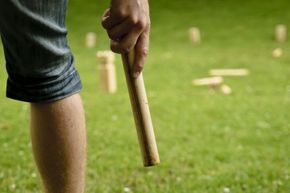Lawn games can be fantastic fun; from bocce ball, to croquet, to ladder balls, to the bean bag toss, these pastimes blend competition and leisure. Throw in a charcoal grill and a cooler of icy drinks and suddenly lawn games become a foundation for a whole outdoors lifestyle. And that's before you've even tried playing kubb.
Kubb (it rhymes with tube and means "block") is ultimately a game where you try to knock down wooden blocks. That's it. Yet this is a lawn game of potentially epic proportions, and one with a potentially horrifying and bloodcurdling history, to boot.
Advertisement
Kubb is a deft combination of simplicity, skill, fortune and strategy that no bean bag game can match. Games can last from anywhere from a few minutes to more than an hour. You can play just about anywhere. And although it seems a bit complicated at first, kubb is actually a straightforward pursuit. For many players, it's also ridiculously addictive.
The game is sometimes called a cross between horseshoes, bowling and golf. Yawning already? Don't click away just yet, because kubb combines the best elements of those games for a strangely primal challenge.
In Kubb, there are three types of playing pieces: six batons, 10 kubbs and a king. The batons are cylinders 12 inches (30.5 centimeters) long. The kubbs are blocks 2.75 inches (7 centimeters) square and 6 inches (15.2 centimeters) tall. And the king is a block 3.5 inches (8.9 centimeters) square and 12 inches (30.5 centimeters) tall, and is often topped with a perky crown.
Opposing teams, which consist of anywhere from one to 20 players, take turns throwing batons in an attempt to knock down the other team's kubbs, which are placed at opposite ends of a rectangular pitch. Once the kubbs are toppled, you can attack the king. Knock down the king and you win the game.
There's more to kubb than immediately meets the eye, though. With intricate details that can turn the tide of a game at any moment, kubb is simple enough for children and layered enough to engage adults for hours at a time.
Keep reading and you'll see more about this oddly invigorating game. Ladderball and lawn darts? We hardly knew ye. Kubb craze is on the march across the globe.
Advertisement



